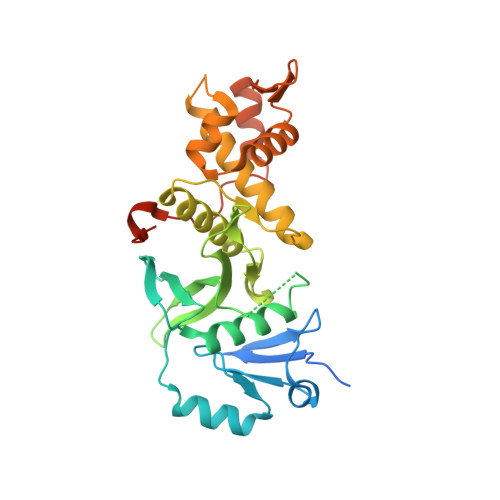Structural and Functional Role of Acetyltransferase hMOF K274 Autoacetylation.
McCullough, C.E., Song, S., Shin, M.H., Johnson, F.B., Marmorstein, R.(2016) J Biol Chem 291: 18190-18198
- PubMed: 27382063
- DOI: https://doi.org/10.1074/jbc.M116.736264
- Primary Citation of Related Structures:
5J8C, 5J8F - PubMed Abstract:
Many histone acetyltransferases undergo autoacetylation, either through chemical or enzymatic means, to potentiate enzymatic cognate substrate lysine acetylation, although the mode and molecular role of such autoacetylation is poorly understood. The MYST family of histone acetyltransferases is autoacetylated at an active site lysine residue to facilitate cognate substrate lysine binding and acetylation. Here, we report on a detailed molecular investigation of Lys-274 autoacetylation of the human MYST protein Males Absent on the First (hMOF). A mutational scan of hMOF Lys-274 reveals that all amino acid substitutions of this residue are able to bind cofactor but are significantly destabilized, both in vitro and in cells, and are catalytically inactive for cognate histone H4 peptide lysine acetylation. The x-ray crystal structure of a hMOF K274P mutant suggests that the reduced stability and catalytic activity stems from a disordering of the residue 274-harboring a α2-β7 loop. We also provide structural evidence that a C316S/E350Q mutant, which is defective for cognate substrate lysine acetylation; and biochemical evidence that a K268M mutant, which is defective for Lys-274 chemical acetylation in the context of a K274-peptide, can still undergo quantitative K274 autoacetylation. Together, these studies point to the critical and specific role of hMOF Lys-274 autoacetylation in hMOF stability and cognate substrate acetylation and argues that binding of Ac-CoA to hMOF likely drives Lys-274 autoacetylation for subsequent cognate substrate acetylation.
Organizational Affiliation:
From the Department of Biochemistry and Biophysics, Abramson Family Cancer Research Institute, Perelman School of Medicine, University of Pennsylvania, Philadelphia, Pennsylvania 19104, the Department of Chemistry, University of Pennsylvania, Philadelphia, Pennsylvania 19104, and.
















